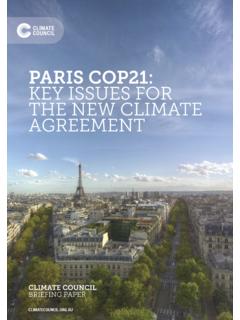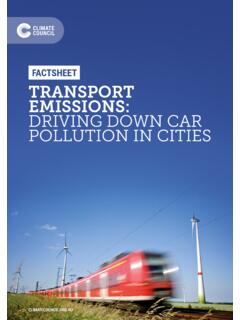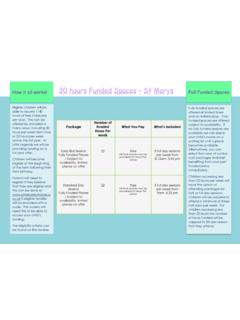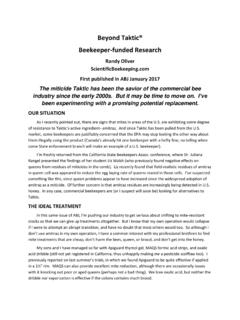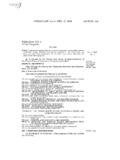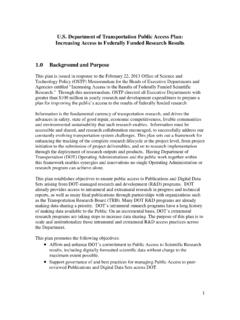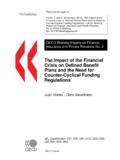Transcription of FULLY CHARGED: RENEWABLES AND STORAGE POWERING …
1 FULLY CHARGED: RENEWABLES AND STORAGE POWERING Climate Council is an independent, crowd- funded organisation providing quality information on climate change to the Australian you for supporting the Climate by the Climate Council of Australia LimitedISBN: 978-1-925573-43-5 (print) 978-1-925573-42-8 (web) Climate Council of Australia Ltd 2018 This work is copyright the Climate Council of Australia Ltd. All material contained in this work is copyright the Climate Council of Australia Ltd except where a third party source is Council of Australia Ltd copyright material is licensed under the Creative Commons Attribution Australia License. To view a copy of this license visit are free to copy, communicate and adapt the Climate Council of Australia Ltd copyright material so long as you attribute the Climate Council of Australia Ltd and the authors in the following manner: FULLY Charged: RENEWABLES and STORAGE POWERING Australia.
2 Authors: Andrew Stock, Greg Bourne, Louis Brailsford and Petra Stock. We would like to thank Dr Matt Stocks (ANU), Andrew Blakers (ANU) and Tim Buckley (IEEFA) for their thorough reviews. Cover image credits: Gemasolar solar thermal power plant, Spain by Flickr user Beyond Coal and Gas Image Library licensed under CC BY-NC and Hornsdale 20161212_30cs by Flickr user David Clarke licensed under CC BY-NC-ND report is printed on 100% recycled Stock Senior Energy and Climate Solutions AnalystLouis Brailsford ResearcherAndrew Stock Climate CouncillorGreg Bourne Climate CouncillorContentsKey Findings ..iiIntroduction ..1 The Facts ..51. The Role of Energy Balancing Supply and Demand Ancillary Services 152. STORAGE Technology.
3 Types of STORAGE Technologies Attributes of Different STORAGE Technologies 293. Prices ..344. Energy STORAGE Projects in the Pipeline in Australia ..40 Glossary ..53 References ..56 Image Credits ..61iCLIMATE COUNCILiiKey FindingsAustralia is on the cusp of an energy STORAGE boom driven by supportive policies and falling costs. Energy STORAGE technologies, like batteries, solar thermal and pumped hydro, can be used to build greater reliability and flexibility into Australia s electricity grid. They can store wind and solar power to provide electricity 24/7. South Australia is already home to the world s most powerful lithium-ion battery, which is already benefiting the power grid by helping meet peak demand, and responding rapidly to coal plant outages.
4 By 2020 the state will also have a 150MW solar thermal plant with heat STORAGE . Victoria, Queensland and the Northern Territory are also investing in grid scale battery STORAGE technology, while the Federal, Queensland and Tasmanian governments are considering developing large pumped hydro projects. Australian households are increasingly embracing battery STORAGE units to complement household solar. In 2016, there were 6,750 new household battery installations with the market predicted to have tripled in size in 2017, with over 20,000 new installations. 74% of people polled from across Australia expect household batteries to be commonplace in homes in the next cost of energy STORAGE solutions is falling rapidly. The cost of lithium-ion batteries has fallen by 80% since 2010.
5 Costs may halve again by 2025. The cost of energy STORAGE technologies is rapidly falling and becoming competitive with peaking gas plants, particularly in light of the trebling of the domestic gas price over the last five years. SolarReserve are building Australia s largest solar thermal plant in South Australia for a levelised cost of no more than $78/MWh - significantly cheaper than a new coal power station. Solar thermal plants can both generate and store electricity. Pumped hydro powered by RENEWABLES is the cheapest form of large-scale energy STORAGE . However, the Climate Council has significant concerns about the Federal Government s Snowy mega-project, as the project is not accompanied by new investment in CHARGED: RENEWABLES AND STORAGE POWERING AUSTRALIAKEY FINDINGSiii45 Energy STORAGE is critical for building a reliable, modern Australian electricity grid for the 21st centur y.
6 Energy STORAGE technologies are ideally suited to the needs of a modern, smart grid providing electricity when and where it is needed. Energy STORAGE can complement high levels of wind and solar power in the electricity grid by storing excess renewable energy. Countries such as Germany, Spain, Ireland and Denmark together with major economies like California have all successfully integrated much higher levels of wind and solar (20% to over 50%) into their electricity grids without compromising reliability. Australia could reach 50% RENEWABLES by 2030 without significant new energy STORAGE . Renewable energy currently produces just 16% of our electricity supply. Batteries, solar thermal and pumped hydro technologies are more flexible and can respond faster to changes in supply and demand than traditional coal and gas plants, and therefore can enhance the reliability of Australia s grid.
7 The Australian electricity grid and old fossil fuelled power stations are increasingly vulnerable to worsening extreme weather events, particularly as these power stations age. Over half of Australia s coal fleet will be over 40 years old by 2030. Having a variety of STORAGE technologies will improve the flexibility and resilience of the power STORAGE is a crucial technology for tackling climate change. Climate change, largely driven by the burning of coal, oil and gas, is worsening extreme weather events such as heatwaves and bushfires in Australia. Given our heavy reliance on coal power stations, the electricity sector in Australia is a major source of pollution. Australia s electricity supply needs to reach a minimum of 50% renewable energy by 2030 and zero emissions well before 2050 to effectively tackle climate change.
8 Energy STORAGE technologies are a vital complementary technology to renewable energy enabling Australia to transition to a clean, reliable, affordable electricity STORAGE technologies - batteries, pumped hydro and solar thermal - ensure supply and demand of electricity are kept in balance and can strengthen the electricity grid to overcome major the past year, energy STORAGE has become an increasingly prominent focus for policy-makers and commentators when considering the future of Australia s electricity grid. In particular, energy STORAGE technologies can potentially address all three elements of the energy policy trilemma : energy security and reliability; affordability; and emissions reduction. This report describes how the strategic use of distributed, utility scale energy STORAGE in Australia s electricity grid can simultaneously ensure a secure, reliable, clean and increasingly affordable electricity supply.
9 Since the 1970s, the global average temperature has trended strongly upwards, with global temperature now 1 C above pre-industrial levels. 2017 was the third warmest year on record, and the warmest non-El Ni o year ever recorded. This comes on the back of the world s hottest year in 2016. Greenhouse gas pollution from the burning of fossil fuels (coal, oil and gas) are driving increasing temperatures. Rising temperatures and the accelerating impacts of climate change are affecting all nations, including Australia. Heatwaves are now hotter, lasting longer and occurring more often. Australia s ageing coal-fired power stations are vulnerable to extreme heat. The ocean is also warming. Rising sea surface temperatures, driven by climate change, are increasing the prevalence of marine heatwaves , which can trigger coral bleaching events, like those seen in 2016 and 2017 on the Great Barrier Reef.
10 The reef is an environmental treasure, as well as a key tourism and fisheries asset. Climate change has also increased extreme bushfire weather in the south and east of Australia since the 1970s, threatening people and property, while climate change is likely making drought conditions in southwest and southeast Australia worse. At the same time, sea level has been rising rapidly, exposing coastal infrastructure and property to increasing coastal erosion and higher risk of inundation from storm surges. Australia s fossil fuel dominated electricity sector is the nation s single largest source of greenhouse gas pollution, accounting for over a third of Australia s total emissions. Tackling climate change requires transitioning away from fossil fuels for electricity to renewable energy generation and number of countries rely on a significant quantity of renewable CHARGED: RENEWABLES AND STORAGE POWERING AUSTRALIAINTRODUCTIONS torage technology allows renewable energy to be continuously , the transition to renewable energy is seemingly unstoppable - driven by record-breaking capacity additions, rapidly falling costs and increasing capital markets appetite for renewable energy infrastructure (REN21 2017).
